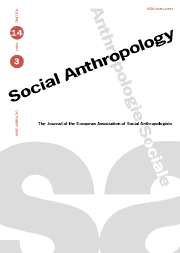Architecture of immanent power. Truth and nothingness in a Japanese bureaucratic machine
Published online by Cambridge University Press: 07 October 2004
Abstract
A great bureaucratic machine works, as its subdued humming testifies, between and within sentient motifs. A social agent, who is a patient/agent within a series of self-proliferating motifs, does not need to know its reason in order to function within it. What is crucial for the reproduction of the bureaucratic machine are the part-to-part and part-to-whole cause and effect relationships between these sentient motifs combined with the performance of a beautiful, monolithic facade. As described by Kafka (and to a lesser extent Foucault), power is architecturally immanent in the modern bureaucratised world. I propose to use an action-centred biographical model of Alfred Gell (which he developed to analyse processes of decorative pattern formation) to capture how the immanent power of architecture works.
Un grand appareil bureaucratique fonctionne, comme son ronronnement doux témoigne, entre et à l'intérieur des motifs sensibles. Un agent social, qui est le patient/agent à l'intérieur d'une série de motifs qui s'auto-multipient, ne connaît pas sa raison de fonctionner dans ce cadre. Ce qui est crucial pour la reproduction de l'appareil bureaucratique sont les rapports de cause (d'une pièce à une autre ou d'une pièce à la totalité) entre ces motifs sensibles en combinaison avec la réalisation d'une belle façade monolithique. Comme Kafka – et dans une moindre mesure Foucault – l'ont montré, le pouvoir est immanent de façon architecturale dans le monde bureaucratisé moderne. Mon intention est d'utiliser le modèle biographique – et centré sur l'action – d'Alfred Gell (ce qu'il a développé pour analyser la formation des motifs décoratifs) afin de déceler comment le pouvoir immanent de l'architecture fonctionne.
Eine grosse bürokratische Machine arbeitet, wie ihr unterdrücktes Brummen bezeugt, zwischen und inmitten von empfindungsfähigen Motiven. Ein sozial Handelnder, der Patient/Agent innerhalb einer Serie von sich selbst vervielfältigenden Motiven ist, braucht den Sinn dieser Machine nicht zu kennen um darin funktionieren zu können. Entscheidend für die Reproduktion der bürokratischen Machine sind die kausalen (Teil-zu-Teil und Teil-zum Ganzen) Beziehungen zwischen diesen empfindungsfähigen Motiven, kombiniert mit der Vorstellung einer schönen, monolithischen Fassade. Wie Kafka (und in geringerem Maße Foucault) beschrieben haben, ist Macht der modernen bürokratisierten Welt architektonisch immanent. Ich schlage vor, das aktionszentrierte biografische Modell Alfred Gells, das er für die Analyse von Prozessen des Zustandekommens dekorativer Muster entwickelte, zu gebrauchen um die immanente Macht der Architektur zu erfassen.
Toda máquina burocrática funciona, como su zumbido latente atestigua, entre y desde motivos sentientes. No es necesario que los actores sociales, a su vez agentes/pacientes en secuencias de motivos auto-generativos, conozcan su racionalidad para poder conducirse en su interior. Lo que sí resulta imprescindible para la reproducción de la máquina burocrática son las relaciones causa-efecto entre las partes (parte-parte, parte-todo) de los motivos sentientes, así como la realización de una fachada monolítica e impresionante. Como ya describiera Kafka (y en menor medida Foucault), el poder en el mundo burocrático moderno es inmanentemente arquitectural. El artículo propone usar el modelo de acción biográfica de Alfred Gell (pensado para analizar la formación de patrones decorativos) para entender cómo funciona el poder inmanente de la arquitectura.
- Type
- Research Article
- Information
- Copyright
- © Cambridge University Press 2004
Footnotes
- 4
- Cited by




